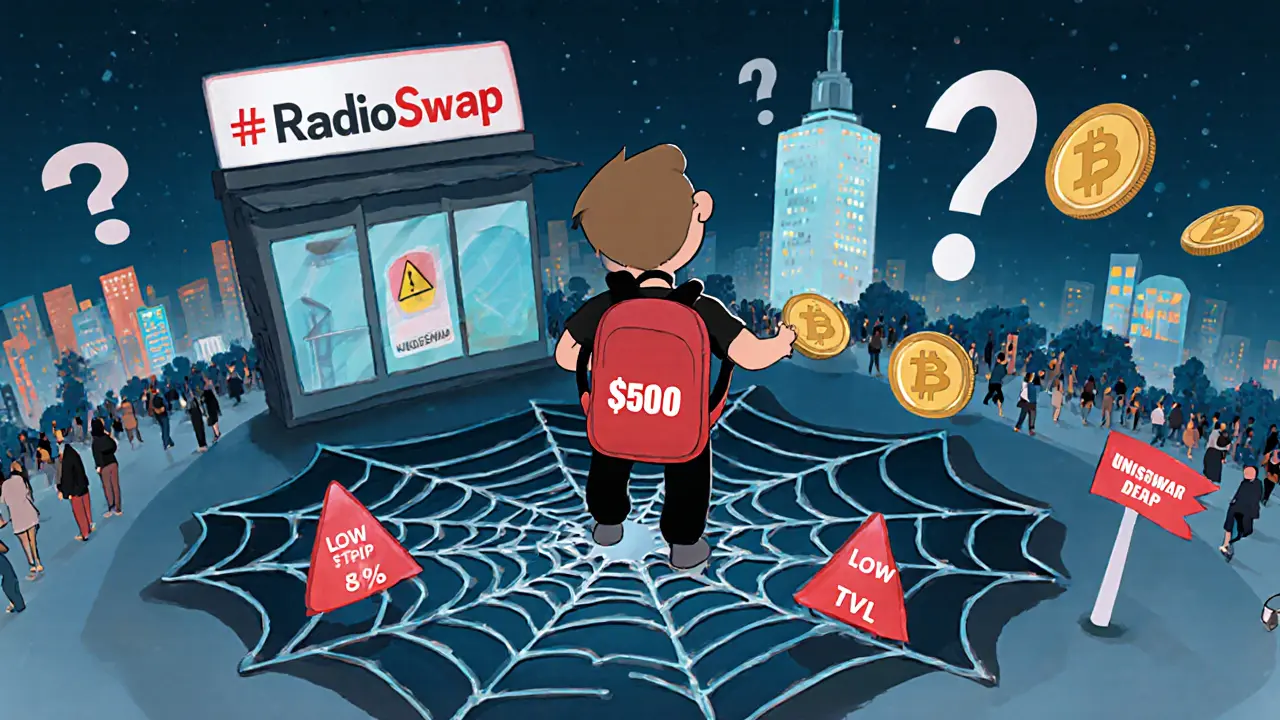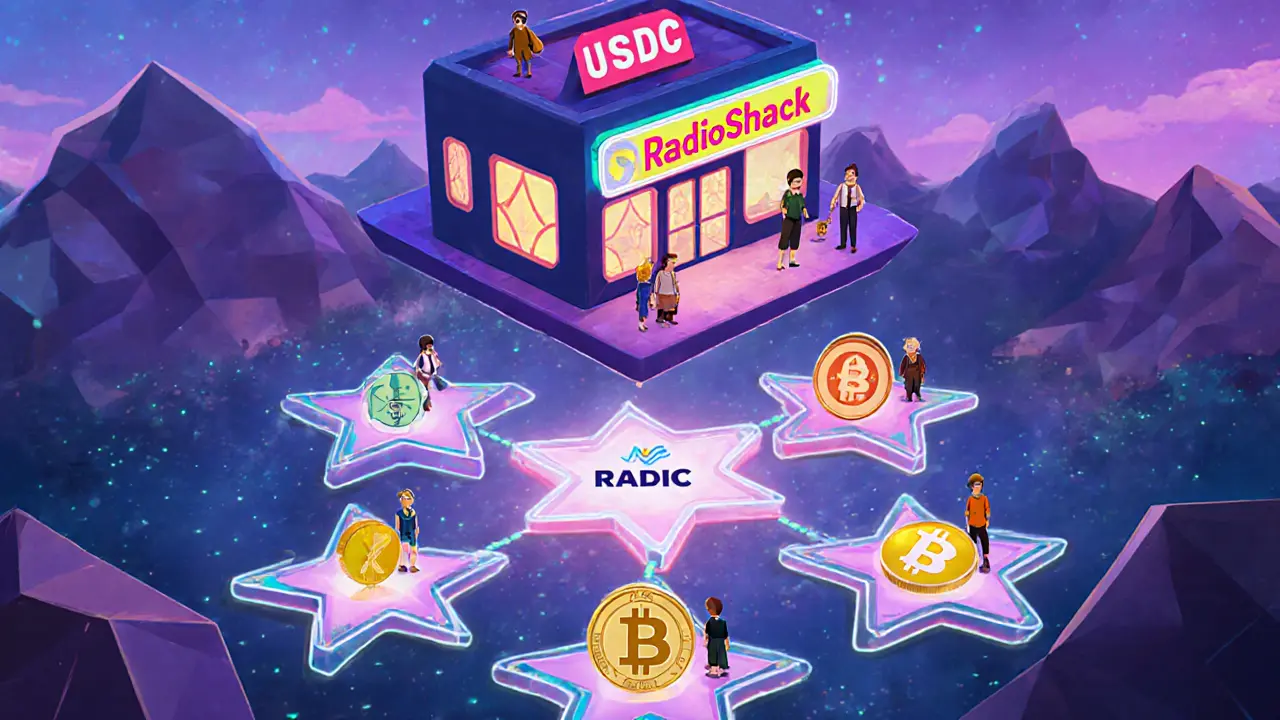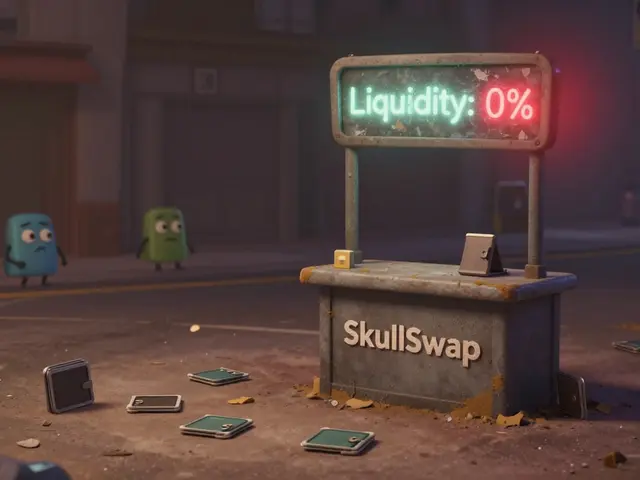DEX Slippage Calculator
Calculate Your Trade Loss
RadioShack isn’t the electronics store you remember from the 90s. It’s now a blockchain project built on Polygon, trying to reinvent how decentralized exchanges handle liquidity. The name grabs attention-everyone knows RadioShack. But does the tech behind RadioShack Swap actually work? Or is it just clever branding with thin liquidity?
What Is RadioShack Swap?
RadioShack Swap is a decentralized exchange (DEX) running on the Polygon network. Unlike big names like Uniswap or PancakeSwap, it doesn’t use the standard constant product formula (x*y=k). Instead, it uses something called the “Starfish Topology.” Think of it like a spiderweb with one central point-the RADIO token. Every other token connects directly to RADIO, not to each other. So if you want to trade USDC for MATIC, you don’t go USDC → MATIC. You go USDC → RADIO → MATIC. The idea? Reduce the number of steps, cut slippage, and concentrate liquidity where it matters most.This isn’t just theory. The team behind it claims this structure solves the problem of fragmented liquidity that plagues most DEXs. On Uniswap, liquidity is spread thin across thousands of token pairs. On RadioShack Swap, nearly all liquidity is funneled through one token: RADIO. That’s the whole pitch.
The RADIO Token: The Heart of the System
The RADIO token is the engine. It’s deployed on Polygon, Ethereum, Avalanche, and Celo. Its contract on Polygon is0x613a489785C95afEB3b404CC41565cCff107B6E0. As of October 31, 2025, the token price was around $0.000357. Sounds cheap, right? But here’s the catch: CoinMarketCap lists a circulating supply of 3.4 billion tokens, while the total supply is reported as 1 billion. That’s impossible. Either the data is wrong, or there’s a problem with how supply is being tracked. Either way, it’s a red flag.
Market cap hovers near $1.08 million. That’s tiny compared to Uniswap’s $3.2 billion in total liquidity across chains. Even QuickSwap, another Polygon DEX, has over $100 million in liquidity. RadioShack Swap’s total value locked (TVL) is just $969,800. That’s not enough to handle big trades without major slippage.
Volume Claims vs. Reality
This is where things get messy. Some sources say RadioShack Swap hit $40 million in daily volume. Others say it’s under $1.2 million. Coinbase, CoinMarketCap, and DEXScreener all show wildly different numbers. The truth? On-chain data from DEXScreener and DeFi Llama points to the lower end. The $40 million figure appears to be inflated-possibly from marketing or bot activity. Real users aren’t trading that much.Compare that to QuickSwap, which processes $18.3 million in 24-hour volume on Polygon alone. Or SushiSwap, which hits $8.2 million. RadioShack Swap doesn’t come close. If you’re looking for a DEX with real trading activity, this isn’t it.

How It Works: Step by Step
If you still want to try it, here’s how to use RadioShack Swap:- Install a Web3 wallet like MetaMask or Trust Wallet.
- Switch your network to Polygon (RPC: https://polygon-rpc.com).
- Get some MATIC to pay for gas. You’ll need at least 0.5 MATIC.
- Go to radioshackswap.com (verify the URL-scams exist).
- Connect your wallet.
- Choose the tokens you want to swap. Only 87 pairs are available.
- Set slippage to 1-2% for small trades. Above $500? Expect 5-8% slippage.
- Confirm the transaction.
For small swaps under $500, it works fine. One Reddit user reported a smooth $300 USDC to WETH swap with less than 1% slippage. But at $2,000, the same user saw 8.2% slippage. That’s a $164 loss on a $2,000 trade. Not worth it.
Pros and Cons
Pros
- Clean, simple interface-easier to use than Uniswap for beginners.
- Low gas fees thanks to Polygon.
- Unique liquidity model could work if adoption grows.
- Multi-chain support (Ethereum, Avalanche, Celo).
- Staking and yield farming options available.
Cons
- Extremely low liquidity-don’t trade over $500.
- Only 87 token pairs. QuickSwap has over 1,200.
- Conflicting volume data raises trust issues.
- Supply numbers don’t add up (circulating > total).
- Small community (4,852 on Telegram vs. 125,000+ for Uniswap).
- No official support team. Only community Discord and Telegram.
Who Is This For?
RadioShack Swap isn’t for most crypto traders. If you’re swapping $5,000 or more, go to QuickSwap, SushiSwap, or 1inch. If you’re an institutional investor? Forget it. The slippage and low liquidity make it unusable.It’s only worth considering if:
- You’re experimenting with new DeFi models and don’t mind risk.
- You’re holding RADIO and want to stake it for yield.
- You’re a speculator betting the project will blow up.
- You’re curious about the “Starfish Topology” and want to test it on a small scale.
For everyone else? Stick with established DEXs. They’re safer, faster, and cheaper.

How It Compares to Other Polygon DEXs
| DEX | 24h Volume | TVL | Token Pairs | Slippage on $2k Trade | Community Size |
|---|---|---|---|---|---|
| RadioShack Swap | $1.2M (verified) | $969,800 | 87 | 5-8% | 4,852 (Telegram) |
| QuickSwap | $18.3M | $112M | 1,245 | 0.3-0.8% | 78,000 (Discord) |
| PancakeSwap (Polygon) | $12.7M | $89M | 950+ | 0.2-0.6% | 140,000 (Discord) |
| SushiSwap (Polygon) | $8.2M | $65M | 800+ | 0.4-1% | 55,000 (Discord) |
RadioShack Swap is nowhere near the competition. Even if you believe in the Starfish model, the numbers don’t support it yet. The liquidity is too shallow. The user base is too small. The volume claims are too inconsistent.
Future Outlook: Hope or Hype?
The roadmap says RadioShack plans to integrate Solana and Cosmos by mid-2026. It also plans to add concentrated liquidity (like Uniswap v3) by the end of 2025. That’s promising-if they execute. But execution is the problem. They’ve had over a year to build traction. Their wallet interactions? Only 1,842 unique addresses in the last 30 days. QuickSwap had over 142,000.Some analysts think RadioShack could succeed if it partners with a big Polygon-based gaming project. Gaming tokens need liquidity. If they get that, the Starfish model might work. But right now? No such partnership exists.
The RadioShack brand gives it marketing power. But in crypto, brand recognition doesn’t replace liquidity. You can’t trade a name. You trade volume.
Final Verdict
RadioShack Swap is an interesting experiment. The Starfish Topology is smart in theory. But theory doesn’t pay bills. Real liquidity does.For now, it’s a niche play. Only use it if you’re trading under $500 and you’re okay with high slippage on larger trades. Don’t stake large amounts of RADIO unless you’re ready to lose it if the project fades. And never trust volume numbers without checking DEXScreener or DeFi Llama yourself.
If you want to explore Polygon DEXs, start with QuickSwap or SushiSwap. They’re proven, liquid, and safe. RadioShack Swap? It’s a gamble. And right now, the odds aren’t in your favor.
Is RadioShack Swap a legitimate crypto exchange?
Yes, it’s a real decentralized exchange built on Polygon with live smart contracts. But legitimacy doesn’t mean safety or reliability. The project has low liquidity, conflicting volume reports, and a tiny user base. It’s not a scam, but it’s not a trustworthy platform for serious trading.
Can I make money staking RADIO tokens?
You can stake RADIO and earn rewards, but the risk is high. With only $1 million in total liquidity, the protocol can’t support large staking pools. If users pull their liquidity, the rewards could vanish overnight. Also, the token’s price is extremely volatile and unproven. Only stake what you can afford to lose.
Why is the circulating supply higher than the total supply?
This is a data error. Total supply can’t be less than circulating supply. Either the token contract has a bug, or the data providers (like CoinMarketCap) are misreading the blockchain. Either way, it’s a major red flag. Always verify token supply on-chain using a block explorer like Polygonscan.
How does RadioShack Swap compare to Uniswap?
Uniswap has over 100x more liquidity, 10x more token pairs, and 100x more users. RadioShack’s Starfish model is a theoretical alternative, but it hasn’t proven itself. Uniswap works at scale. RadioShack doesn’t. For most users, Uniswap is faster, cheaper, and safer.
Should I invest in the RADIO token?
Only if you’re speculating. The token has no utility beyond being a liquidity node. There’s no revenue, no team transparency, and no clear path to adoption. With a market cap under $2 million and no major partnerships, it’s a high-risk, low-reward play. Treat it like a lottery ticket, not an investment.
Is RadioShack Swap safe to use?
Technically, yes-its contracts are audited and live on Polygon. But safety isn’t just about code. It’s about liquidity, community, and sustainability. With minimal user activity and unverified volume claims, the platform is vulnerable to manipulation or collapse. Use it only with small amounts you’re willing to lose.




Comments
lol radio shack dex bruh
the supply thing is wild - circulating > total? that’s not a typo, that’s a red flag with a neon sign and a kazoo orchestra. if they can’t even get basic math right, why should i trust their ‘starfish topology’? it’s just a spiderweb with delusions of grandeur.
you think this is bad wait till you see the team’s linkedin profiles - one guy says he’s a ‘blockchain visionary’ but his last job was at a vape shop in Bangalore. this isn’t innovation it’s cosplay with smart contracts. the only thing starfish-like here is how they’re all just flopping around in the deep end hoping someone throws them a life raft.
hey everyone - i’ve been testing this on my small wallet and honestly if you’re just swapping under $200 it’s kinda fun. low fees, clean ui, and the slippage is manageable. i’m not putting my life savings in it but if you wanna dabble and support a new idea? why not? crypto’s about experimentation. just keep it small and stay aware. 🙌
the volume discrepancy is statistically implausible. DEXScreener shows $1.2M, CoinMarketCap shows $40M - that’s a 33x variance. no legitimate analytics firm would tolerate such inconsistency. this is either incompetence or deliberate obfuscation. either way, it’s a non-starter for any serious participant.
the starfish topology is actually kind of beautiful in its simplicity - it’s like the universe collapsing into a singularity of liquidity. we’ve been stuck in the chaos of AMMs for too long. maybe this is the next phase of decentralization - not more pairs, but deeper focus. sure the numbers are ugly now but so was bitcoin at $0.01. history favors the bold - or at least the delusional.
the fact that they named it after a place where you used to buy batteries and a 90s boombox… and now it’s a crypto project? i mean, i respect the irony. but also - please don’t make me buy RADIO tokens to pay for my next pair of noise-canceling headphones. i’m not ready for this level of postmodern branding.
bro i tried this last week with 50 bucks - swapped USDC to DAI, 0.7% slippage, gas was 0.02 MATIC. felt like i was in 2021 again. the interface is smooth, the devs are quiet but the site loads. if this thing blows up in 6 months i’ll be like ‘yo i knew it’ - if it dies? i lost 50 bucks and got a good laugh. crypto’s a carnival - sometimes you gotta ride the broken rollercoaster.
i get that some of you are skeptical - and you should be. but don’t forget that every big thing started small. if you’re not willing to try something new unless it’s already proven, you’ll miss out on the next big thing. just keep your risk small, track the on-chain data, and stay curious. you don’t have to bet your rent money - just your curiosity.
wait so if i trade USDC to MATIC i’m really just trading USDC to RADIO then RADIO to MATIC? so RADIO is acting like a central hub? that’s… oddly elegant. kind of like how English became the lingua franca even though it’s not native to most people. it’s not about being the best - it’s about being the most connected. i’m not investing but i’m definitely watching.
the whole thing is a marketing stunt wrapped in a whitepaper and sold to gullible reddit users who think ‘polygon’ means ‘safe’ and ‘radio shack’ means ‘trustworthy’. the tvl is less than a single liquidity pool on quickswap. the community is smaller than my aunt’s facebook group for cat memes. and the supply data is so broken it makes me question if the devs even know what a blockchain is. this isn’t innovation it’s a dumpster fire with a website
you people are acting like this is a startup. it’s not. it’s a meme coin with a dapp attached. the ‘starfish topology’ is just a fancy way of saying ‘we put all our eggs in one basket and called it architecture’. if you’re not trading under $100 you’re either rich or stupid. and if you’re staking RADIO? congrats you just bought a lottery ticket with a 98% chance of losing and a 2% chance of being the last one holding the bag.
it’s okay to be skeptical. it’s also okay to be curious. crypto isn’t about being right - it’s about learning. if this fails, you’ll know more about liquidity design. if it succeeds? you got in early. either way, you’re part of the experiment. just don’t go all in. keep it small. stay safe. and if you try it? come back and tell us how it went. we’re all learning together 🌱
the fact that they’re planning to integrate solana and cosmos is actually kind of impressive - even if the execution is shaky. ambition isn’t the problem. execution is. if they can get even 10k daily active users, this could turn into something real. until then? treat it like a beta app you download for fun. not your portfolio.